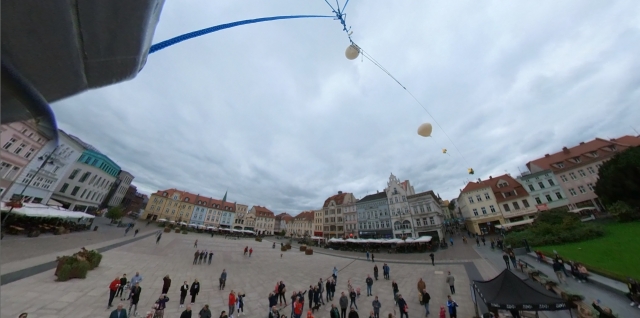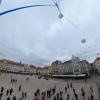During 47 Congress of Polish Physicists, a probe with CosmicWatch detectors was sent into the stratosphere
2021.09.22 16:47 - Marek Pawłowski47 Congress of Polish Physicists takes place in Bydgoszcz on 19–23 September 2021. On September 19, the part of the Congress dedicated to teaching physics was inaugurated by sending a tandem stratospheric probe, which included cosmic rays detectors provided by NCBJ.
The stratospheric mission BHR-21 (Bydgoszcz-Hergesel-Regener) began at noon from the old Market Square in Bydgoszcz. For the first time in Poland a tandem balloon probe was used, which was replicating historic methods invented and practiced by XIX century scientists, Hugo Hergesel and Erich Regener, both of Bydgoszcz origin. The mission goal was to measure the flux of cosmic radiation which was a specialty of Erich Regener. The place of start was carefully selected as well, the 18 meridian honors Marian Rejewski, mathematician and cryptologist from Bydgoszcz. To ensure the safety of the mission, the probe was equipped with multiple independent telemetric systems which allowed the mission organisers to constantly monitor its position and quickly locate it after the landing.
As it sometimes happens with scientific experiments, not everything went according to the plan of the mission organisers. The buoyancy force of one of the balloons, tacting as a parachute during the descent, was too low and right after the start it was placed at the bottom of the probe. After the main balloon burst at 20 km above the ground, the second balloon was entangled in the rigging as well as emergency parachutes and the placement of all the capsules was inverted. Fortunately, the mission landed on a freshly plowed field and despite the rough character of the landing, none of the electronic or optic equipment Was damaged.
The detectors of cosmic radiation used in this mission were a set of two CosmicWatch counters. These devices, designed as a part of an educational project between NCBJ and MIT, work based on a plastic scintillator and silicon photomultiplier (SiPM). The device can register impulses caused by charged ionising particles passing through the scintillator and in result measure their quantity. In order to measure cosmic radiation, one must create a setup using two CosmicWatch detectors and take coincident measurements. In this method, one of the detectors registers only those impulses that are also detected by the second device. This way we mostly measure muons and ignore electrons and gamma radiation. This kind of experiment aims to demonstrate the way in which the number of detected muons changes with altitude.
NCBJ scientists have already sent CosmicWatch detectors to the stratosphere, as a part of the Near Space 2018 conference in Toruń. A similar set of two CosmicWatch detectors reached the altitude of 32 km (Scientists from NCBJ sent educational detectors in near outer space | National Centre for Nuclear Research).
Additional information
47th Congress of Polish Physicists Was organised by Polish Physical Society, Bydgoszcz University of Science and Technology, Ludwik Rydygier Collegium Medicum in Bydgoszcz and Kazimierz Wielki University. The event Was supervised by the Polish Physical Society, department in Bydgoszcz.
The official inauguration of the Congress of Polish Physicists took place on September 20th. Among the guests were highly regarded scientists, such as prof. Frank Wilczek, a Nobel Prize winner of polish origin, who gave a lecture on time crystals. Other guests included e. g. prof. Luc Bergé, the President of European Physical Society and Anna Zielińska, the granddaughter of the world-renown chemist and metallurgist Jan Czochralski, the inventor of a method of monocrystal growth that is widely used to this day. On Monday, September 20, another stratospheric mission was launched, this time focused on meteorological measurements. Similar to the previous day, before the mission start there were extensive preparations accompanied by significant commentary for the audience. The processed data from both missions will be published on the internet in the form of video recordings. This way the interested viewers will be able to experience the entire flight, all while manipulating the camera view, through the use of high-resolution spherical cameras. More information will be posted on the Congress of Polish Physicists website (47 Zjazd Fizyków Polskich PTF (utp. edu. pl) ).
The Sunday session, the opening ceremony as well as plenary lectures were livestreamed through YouTube and are available on the Congress’ channels: 47 Zjazd Fizyków Polskich – YouTube, 47 Zjazd Fizyków Polskich CM UMK – YouTube.




















